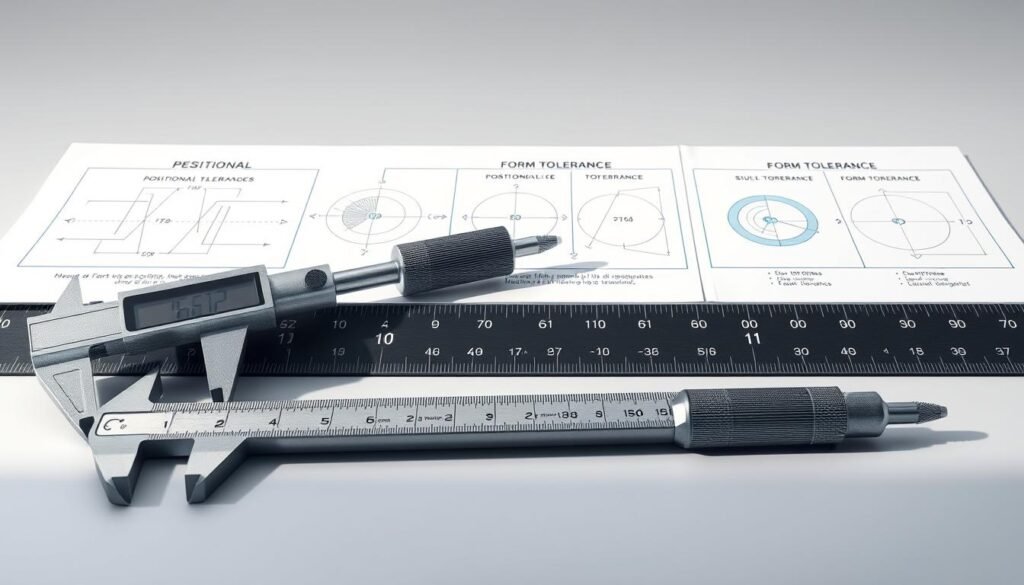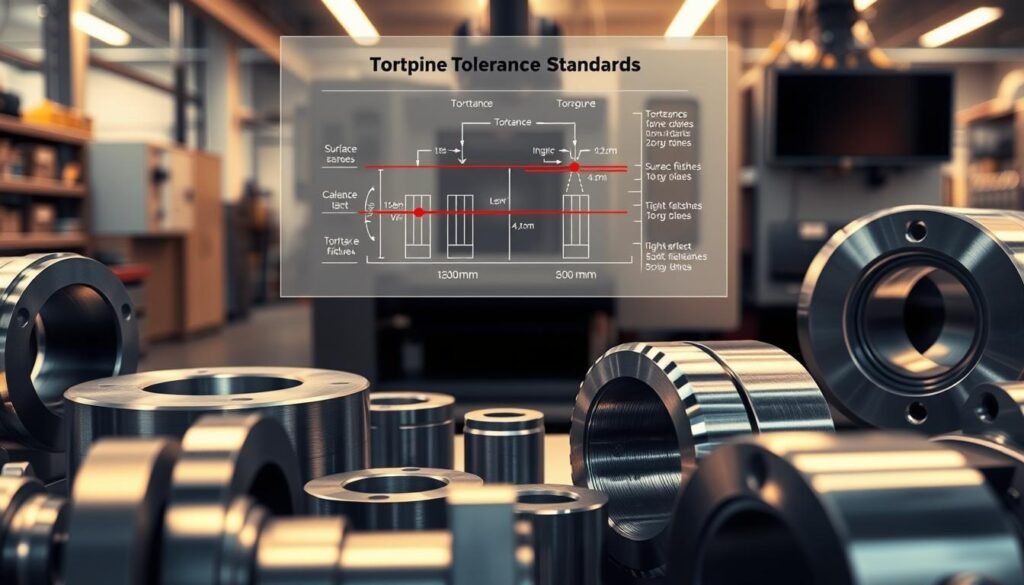Have you ever thought about how sectors such as aerospace, automotive, and healthcare achieve top-notch quality in their parts? It’s all about sticking strictly to CNC machining tolerance standards. But, what exactly are these standards, and why are they crucial for precision in manufacturing?
CNC machining precision isn’t just a tech need; it’s key to making production efficient and saving costs. By sticking to exact tolerances, makers can keep quality steady, cut down on waste, and lower production expenses. This approach is essential for meeting tough industry standards and boosting efficiency in manufacturing.
Key Takeaways
- CNC machining tolerance standards are crucial for achieving high precision.
- Adhering to these standards ensures consistent quality in manufacturing.
- Precision manufacturing helps minimize material waste and reduce production costs.
- Understanding CNC machining accuracy is vital for industries like aerospace, automotive, and healthcare.
- Maintaining precise tolerances enhances overall manufacturing efficiency.
What Are CNC Machining Tolerances?
In CNC machining, knowing about machining tolerance is key. These tolerances are the allowed limits of size changes in machine parts. Following these rules is crucial for the best precision and functionality.
Definition and Importance
The value of machining tolerances is really big. They make sure products look good, work well, and fit together without wasting a lot. These guidelines help ensure that the final piece matches the designer’s vision perfectly. To understand more, check this resource.
Types of Tolerances
Within the industry, there are a few main types of machining tolerances:
- Bilateral tolerances: These are shown as +/- 0.005 in. (or +/- 0.127mm), and allow for size changes in both directions.
- Unilateral tolerances: These can be +0.000/- 0.010 in. or the opposite, allowing changes in just one direction.
- Limit-based tolerances: These are given as ranges like 1.005 / 0.995 in., showing the sizes that are okay.
- Geometrical tolerances: They cover things like true position, flatness, and other shape-related standards.
For instance, surface smoothness is usually set at 63 µ in. for flat sides, and 125 µ in. or lower for rounded ones. Using these machining tolerances is critical for making precise products.
Knowing and applying these set tolerances boosts how well production goes. It also improves the quality of products, making customers happy and ensuring machine parts work reliably.
Different Types of CNC Machining Tolerances
Knowing the various tolerances in CNC machining is key. It helps make sure parts are the right size and work well. Each tolerance type has a special role. They set the allowed changes for parts.
Unilateral Tolerance
A CNC unilateral tolerance is when changes happen only one way from a set size. This means the part’s size can either increase or decrease, but not both. It’s useful when one side of a part is more important. The other side can be more flexible.
Bilateral Tolerance
On the other hand, bilateral tolerance in CNC lets a part’s size go up or down. For example, a part might have a little room to change, like +0.1 mm or -0.1 mm. This allows for some wiggle room in either direction without affecting how the part works.
Limit Tolerances
Limit tolerances examples set the biggest and smallest sizes allowed. They don’t give a specific size. Instead, they create a size range. For instance, a shaft’s width must be within 10.00 mm to 10.05 mm.

Profile Tolerances
Profile tolerances focus on a part’s shape. They make sure parts fit together well. This is key for complex shapes where every detail matters for the part to work right.
Geometrical Tolerances
Geometrical tolerances make sure part features are in the right spot. These include rules for how straight or flat parts must be. They help parts fit together perfectly and work as they should.
| Tolerance Type | Description | Example Application |
|---|---|---|
| CNC Unilateral Tolerance | Tolerance in one direction from the nominal value | Press-fit components |
| Bilateral Tolerance in CNC | Tolerance on both sides of the nominal dimension | General machining |
| Limit Tolerances | Defines max and min permissible sizes | Interchangeable parts |
| Profile Tolerances | Controls variation within a geometric profile | Aerospace components |
| Geometrical Tolerances | Ensures relationships between features | Precision assemblies |
Understanding Geometric Dimensioning and Tolerancing (GD&T)
GD&T basics show us how to make engineering drawings exact and consistent. It uses standard geometric symbols to clearly state the sizes and limits needed for parts and assemblies. This ensures everything is accurate and consistent.
Symbols and Standards
Geometric symbols are key in GD&T for showing different features of parts and assemblies. They cover shape, orientation, and how parts should be placed. Following ISO and ASME standards, these symbols make technical drawings clear and free from misunderstandings.
Common Geometric Tolerances
To understand geometric tolerances well, it’s key to know the most common types. These include:
- Flatness: This ensures a part’s surface is between two parallel planes.
- Straightness: This makes sure a line or an edge is even along its length.
- Roundness: This confirms a surface is as round as a perfect circle.
- Concentricity: This aligns the centers of circles or cylindrical surfaces on the same axis.
By learning these GD&T basics, engineers and machinists can make things with more precision. This leads to products of higher quality and lowers the cost of making them.
| Symbol | Meaning | Application |
|---|---|---|
| ⏤ | Flatness | Ensures even surface |
| — | Straightness | Maintains linearity |
| ⬯ | Roundness | Guarantees circularity |
| ◉ | Concentricity | Aligns central axes |
Using geometric dimensions and tolerances well can make CNC machining more accurate and efficient. This underscores the importance of fully understanding geometric tolerances.
Common CNC Machining Tolerance Standards
In CNC machining, following common machining tolerances is key. This ensures parts are precise and work as they should. Standards like ISO 2768 and ASME Y14.5 provide detailed guidelines. These cover different aspects like linear and angular dimensions, and how flat surfaces should be.
These standards help make sure parts can be swapped easily and work right in their specific uses. For example, ISO 2768 sorts tolerances into groups such as fine and coarse. Each group defines how much a part can vary from the standard.
Also, CNC precision standards are vital in making. They set the allowed differences, cutting down mistakes and boosting quality. So, picking the right standard for your project is essential for the best results in machining work.

| CNC Precision Standard | Specification | Application |
|---|---|---|
| ISO 2768 | Defines general tolerances for linear and angular dimensions | Widely used in Europe, suitable for various engineering fields |
| ASME Y14.5 | Sets forth guidelines for geometric dimensioning and tolerancing | Predominantly used in the United States, applicable in diverse industries |
By sticking to these industry tolerance standards, makers ensure parts meet strict limits. This means consistent quality and parts that fit together well in many areas. Keeping to these standards is a must for precision in today’s manufacturing world.
Factors Affecting Machining Tolerances
It’s vital to know what affects machining tolerances in CNC machining. We’ll explore what elements influence these tolerances.
Material Selection
The impact of materials on tolerances is big. Each material has unique traits. For example, hardness and machinability. These traits affect how tight a tolerance can be. Hard materials like titanium need special tools to keep tolerances tight.
Machining Methods
Different CNC machining methods have their own precision levels. Techniques like milling, turning, and EDM each have pros and cons. For instance, EDM is great for detailed shapes that need a lot of precision.
Surface Finish
The quality of a surface affects tolerances a lot. Smoother surfaces mean tighter tolerances because they’re more consistent. Methods like grinding and polishing improve surface quality and help meet strict tolerances.
Inspection Techniques
Checking tolerances regularly is key to meeting them. Tools like Coordinate Measuring Machines (CMM) give accurate measurements. This ensures parts match the design. Sticking to strict tolerance inspection helps keep quality high.
Conclusion
CNC machining tolerance standards are vital in today’s manufacturing world. They help make parts that are both precise and consistent. By understanding different CNC tolerances, we gain the insights needed for high-quality manufacturing.
Geometric Dimensioning and Tolerancing (GD&T) helps us set exact standards. It uses symbols and norms for better accuracy and communication. This ensures all parts meet strict guidelines. The choice of material, machining methods, and other factors also play a big role.
Following CNC guidelines reduces defects and waste. This increases both efficiency and cost-effectiveness. As technology improves, keeping up-to-date with standards and techniques is essential. By doing so, we ensure we’re leading in precision manufacturing and meeting industry needs with top-notch performance.
FAQ
What are CNC machining tolerances?
CNC machining tolerances are the acceptable limits of how much a part’s size can vary. These limits make sure parts look right and work well together, without wasting material.
Why are CNC machining tolerance standards crucial?
These standards keep parts’ quality and function consistent. They’re key in industries like aerospace and healthcare. They also cut down on waste and cost, making manufacturing more efficient.
What is unilateral tolerance?
Unilateral tolerance means a part’s size can only change in one direction from its intended size. This is important for parts where only one kind of size change is okay.
What is bilateral tolerance?
Bilateral tolerance means a part’s size can go both bigger and smaller from the intended size. This method allows for a fair amount of size change in either direction.
Can you explain limit tolerances?
Limit tolerances set the biggest and smallest size allowed, without a specific target size. They’re used when parts need to fit just right within a certain range.
What are profile tolerances?
Profile tolerances watch over the shape variation in a part. They make sure parts keep the right shape and work correctly when put together.
What role do geometrical tolerances play?
Geometrical tolerances keep part features in line with design needs. They cover flatness, roundness, and more, keeping parts working together right.
What is Geometric Dimensioning and Tolerancing (GD&T)?
GD&T is a detailed way to talk about a part’s size and tolerance needs. It uses special symbols for shape, orientation, and location tolerances of part features.
What are common CNC machining tolerance standards?
ISO 2768 and ASME Y14.5 are standard guides for tolerances. They cover sizes, angles, and flatness, helping in designing parts that work as needed.
How does material selection affect machining tolerances?
The type of material can greatly change how accurate the tolerances can be. Choosing the right material is key for keeping sizes and tolerances correct.
In what ways do machining methods impact tolerances?
Different ways to machine parts, like milling or EDM, have different precision levels. This affects how closely parts can match their intended sizes.
Why is surface finish important for tolerances?
Smoother surfaces can have tighter tolerances. This is because they have fewer bumps and rough spots that could change how parts fit and work together.
What inspection techniques ensure parts meet specified tolerances?
Techniques like using Coordinate Measuring Machines (CMM) regularly check parts. This makes sure they stick to their intended sizes, keeping consistency and quality high in manufacturing.




